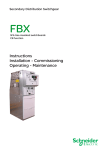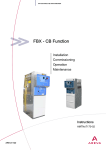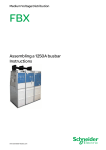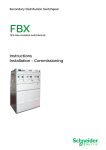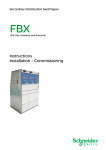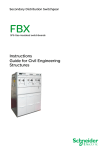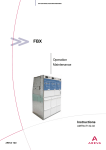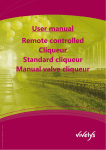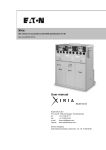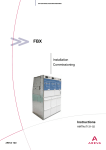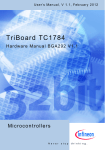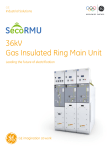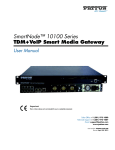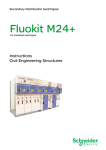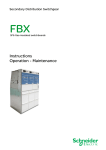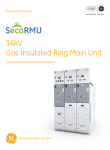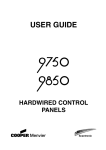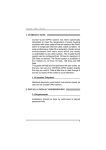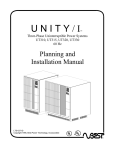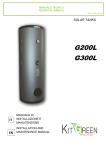Download AMTNoT170-02 SE - Schneider Electric België
Transcript
Secondary Distribution Switchgear FBX SF6 Gas-insulated switchboards CB function Instructions Installation - Commissioning Operating - Maintenance FBX Contents 1 Schneider Electric at your service . . . . . . . . . . . . . . . . . . . 1 1.1 1.2 Our Service Unit: our specialists, and suitably adapted services... . . . . . . . . . Schneider Electric Training: Together, let us develop our skills... . . . . . . . . . . . 1 1 2 With regards to this User Manual . . . . . . . . . . . . . . . . . . . . 2 2.1 2.2 2 2.6 2.7 Responsibilities . . . . . . . . . . . . . . . . . . . . . . . . . . . . . . . . . . . . . . . . . . . . . . . . . . . Reminder concerning normal service conditions (in accordance with the IEC62271-1 standard) . . . . . . . . . . . . . . . . . . . . . . . . . . . . . . . . . . . . . . . . . . . . . . * Permissible ambient temperature . . . . . . . . . . . . . . . . . . . . . . . . . . . . . . . . . . . * Installation altitude . . . . . . . . . . . . . . . . . . . . . . . . . . . . . . . . . . . . . . . . . . . . . . . . * Atmospheric pollution . . . . . . . . . . . . . . . . . . . . . . . . . . . . . . . . . . . . . . . . . . . . . * Permissible atmospheric humidity level . . . . . . . . . . . . . . . . . . . . . . . . . . . . . . Particular instructions for operations and interventions on energized equipment . . . . . . . . . . . . . . . . . . . . . . . . . . . . . . . . . . . . . . . . . . . . . . . Other technical notices to be consulted . . . . . . . . . . . . . . . . . . . . . . . . . . . . . . . . Tools and products (not supplied) required for the operations described in this user manual . . . . . . . . . . . . . . . . . . . . . . . . . . . . . . . . . . . . . . . . . . . . . . . . . Symbols & conventions . . . . . . . . . . . . . . . . . . . . . . . . . . . . . . . . . . . . . . . . . . . . . Tightening torque values [Nm] for standard assemblies (nut + bolt) . . . . . . . . . 3 Presentation of the 630 A CB Functional Unit . . . . . . . . . 4 3.1 3.2 Presentation of the CB Functional Unit's mimic diagram . . . . . . . . . . . . . . . . . . Locking-out by padlock (not supplied) . . . . . . . . . . . . . . . . . . . . . . . . . . . . . . . . . 4 5 4 Packaging - Storage - Unpacking - Handling . . . . . . . . . . 6 4.1 4.2 4.3 Packaging - Storage . . . . . . . . . . . . . . . . . . . . . . . . . . . . . . . . . . . . . . . . . . . . . . . Unpacking . . . . . . . . . . . . . . . . . . . . . . . . . . . . . . . . . . . . . . . . . . . . . . . . . . . . . . . . Handling . . . . . . . . . . . . . . . . . . . . . . . . . . . . . . . . . . . . . . . . . . . . . . . . . . . . . . . . . 6 6 6 5 Installation - Fixing - Connection of the HV cables . . . . 7 5.1 5.2 5.3 5.4 5.5 Installation and fixing to the floor . . . . . . . . . . . . . . . . . . . . . . . . . . . . . . . . . . . . . Earthing . . . . . . . . . . . . . . . . . . . . . . . . . . . . . . . . . . . . . . . . . . . . . . . . . . . . . . . . . . Cable connections . . . . . . . . . . . . . . . . . . . . . . . . . . . . . . . . . . . . . . . . . . . . . . . . . Fitting of a metering core on one or two cables per phase (optional) . . . . . . . . Example of cable connections with a single core per phase . . . . . . . . . . . . . . . 7 7 7 7 7 6 Mechanical interlocks . . . . . . . . . . . . . . . . . . . . . . . . . . . . . . . 9 6.1 6.2 Functional mechanical interlocks . . . . . . . . . . . . . . . . . . . . . . . . . . . . . . . . . . . . . ”Operating” interlocks by locks . . . . . . . . . . . . . . . . . . . . . . . . . . . . . . . . . . . . . . . Use of HV/LV/Transformer non-return interlocking on a CB function . . . . . . . . Representation of lock-type interlocks . . . . . . . . . . . . . . . . . . . . . . . . . . . . . . . . . Installation of lock-type interlocks . . . . . . . . . . . . . . . . . . . . . . . . . . . . . . . . . . . . 9 9 9 10 10 7 Use of the CB function . . . . . . . . . . . . . . . . . . . . . . . . . . . . . . 11 7.1 7.2 7.3 7.4 7.5 7.6 7.7 7.8 Operating accessories . . . . . . . . . . . . . . . . . . . . . . . . . . . . . . . . . . . . . . . . . . . . . Opening the earthing switch . . . . . . . . . . . . . . . . . . . . . . . . . . . . . . . . . . . . . . . . . Closing the earthing switch . . . . . . . . . . . . . . . . . . . . . . . . . . . . . . . . . . . . . . . . . . Closing the line isolating switch [earthing switch open - circuit breaker tripped] Opening the line isolating switch [circuit breaker tripped] . . . . . . . . . . . . . . . . . Closing the circuit breaker [Line Isolator closed] . . . . . . . . . . . . . . . . . . . . . . . . Re-arming the CB closing spring [CB closed] . . . . . . . . . . . . . . . . . . . . . . . . . . . Opening the circuit breaker [Line Isolator closed] . . . . . . . . . . . . . . . . . . . . . . . 11 11 11 12 12 13 13 14 2.3 2.4 2.5 2 3 3 3 3 8 CB Function diagram . . . . . . . . . . . . . . . . . . . . . . . . . . . . . . . 15 8.1 ”Metering - Protection - Signalling” section . . . . . . . . . . . . . . . . . . . . . . . . . . . . . 'Control' section . . . . . . . . . . . . . . . . . . . . . . . . . . . . . . . . . . . . . . . . . . . . . . . . . . . LV Fuse board (SCHURTER, 5x20) . . . . . . . . . . . . . . . . . . . . . . . . . . . . . . . . . . 15 16 16 9 WIC1 or DPX-1 protection relays (option) . . . . . . . . . . . . . 17 9.1 9.2 9.3 Configuring the protection relays . . . . . . . . . . . . . . . . . . . . . . . . . . . . . . . . . . . . . WIC1 & DPX-1 protection relays . . . . . . . . . . . . . . . . . . . . . . . . . . . . . . . . . . . . . WI1-SZ5 fault indicator . . . . . . . . . . . . . . . . . . . . . . . . . . . . . . . . . . . . . . . . . . . . . 17 17 17 8.2 AMTNoT170-02 revision: 04 2 2 2 2 2 i FBX ii 10 Maintenance . . . . . . . . . . . . . . . . . . . . . . . . . . . . . . . . . . . . . . . 18 10.1 10.2 10.3 10.4 10.5 10.6 10.7 10.8 10.9 10.10 10.11 10.12 10.13 10.14 Levels of maintenance . . . . . . . . . . . . . . . . . . . . . . . . . . . . . . . . . . . . . . . . . . . . . General Safety Instructions . . . . . . . . . . . . . . . . . . . . . . . . . . . . . . . . . . . . . . . . . Maintenance of the mechanical control mechanism . . . . . . . . . . . . . . . . . . . . . . Corrective maintenance . . . . . . . . . . . . . . . . . . . . . . . . . . . . . . . . . . . . . . . . . . . . Removal of the protective cover for all maintenance operations . . . . . . . . . . . Location of LV components . . . . . . . . . . . . . . . . . . . . . . . . . . . . . . . . . . . . . . . . . . To replace the motor (1) [See § 10.6] . . . . . . . . . . . . . . . . . . . . . . . . . . . . . . . . . . Replacement of the tripping coil (2) [See Section 10.6] . . . . . . . . . . . . . . . . . . . Replacing an under/overvoltage tripping coil (3 or 4) [See Section 10.6] . . . . . To replace the striker (5) [See section 10.6] . . . . . . . . . . . . . . . . . . . . . . . . . . . . Replacing the undervoltage tripping coil (6) control board [See section 10.6] . Replacing the diode bridge (7) [See section 10.6] . . . . . . . . . . . . . . . . . . . . . . . Replacing the motor control board (8) [See Section 10.6] . . . . . . . . . . . . . . . . . Replacing a motor re-arming contact (9) [mechanical control tripped and un-armed] . . . . . . . . . . . . . . . . . . . . . . . . . . . . . . . . . . . . . . . . . . . . . . . . . . . . Adjust the motor arming lock before the contacts . . . . . . . . . . . . . . . . . . . . . . . Adjusting the electrical arming contacts . . . . . . . . . . . . . . . . . . . . . . . . . . . . . . . 18 18 18 18 19 19 20 21 22 23 23 24 24 11 Spare parts for the circuit breaker . . . . . . . . . . . . . . . . . . . 26 11.1 11.2 11.3 Intervention levels . . . . . . . . . . . . . . . . . . . . . . . . . . . . . . . . . . . . . . . . . . . . . . . . . The spare part . . . . . . . . . . . . . . . . . . . . . . . . . . . . . . . . . . . . . . . . . . . . . . . . . . . . Identification and storage of the parts . . . . . . . . . . . . . . . . . . . . . . . . . . . . . . . . . 26 26 26 12 Notes . . . . . . . . . . . . . . . . . . . . . . . . . . . . . . . . . . . . . . . . . . . . . . 27 25 25 25 AMTNoT170-02 revision: 04 FBX 1 Schneider Electric at your service Operations and maintenance may only be carried out by personnel who have received suitable authorisation for the operations and manœuvres they are responsible for performing. If this is not the case, please refer to our Service Unit or Training Centre. 1.1 All locking-out operations must be performed according to the ”General Safety Instructions booklet for Electrical Applications” UTE C 18 510 (or its equivalent outside FRANCE). Our Service Unit: our specialists, and suitably adapted services... Guarantee extension contracts in relation to the selling of new equipment, Supervision of HVA switchgear installations, Technical advice, diagnoses of the facilities, expertise, Maintenance contracts adapted to operational constraints, Systematic or conditional preventive maintenance, Corrective maintenance in case of partial or complete failure, Supply of spare parts, Overhauling of equipment and requalification of installations in order to benefit from new technologies and extend the life of your switchgear by limited investments. J J J J J J J J Contact the Schneider Electric Service Unit for diagnoses and advice: Working hours ) 33 (0)3 85 29 35 00 33 (0)3 85 29 36 30 or 33 (0)3 85 29 36 43 1.2 Schneider Electric Training: Together, let us develop our skills... We can place at your disposal all of our trainers' expertise, our teams' pedagogical experience and the wealth of our equipment, to help you face the challenge of encouraging the personal development of each individual through the optimisation of their skills. From a few hours up to several weeks, Schneider Electric Training has the control over all of the teaching processes in order to meet the needs of each customer. J J J J Specific training, directly operational with practical work on real machines. Small groups to facilitate communication. Balance between theory and practice. Evaluation and management of the skills: Measurement and optimisation of the trainees' knowledge. Faced with the direct and indirect training costs of the operational stoppages and shutdown, training is a real investment Schneider Electric France Training Centre 35 rue Joseph Monier - CS 30323 - F-92506 Rueil-Malmaison Cedex www.schneider-electric.fr/formation AMTNoT170-02 revision: 04 1 FBX 2 With regards to this User Manual © - Schneider Electric - 2010. Schneider Electric, the Schneider Electric logo and their figurative forms are Schneider Electric registered trademarks. The other brand names mentioned within this document, whether they be copyright or not, belong to their respective holders. 2.1 Responsibilities Our devices are quality controlled and tested at the factory in accordance with the standards and the regulations currently in force. Apparatus efficiency and apparatus life depend on the compliance with the installation, commissioning and operation instructions described in this user manual. Non respect of these instructions is likely to invalidate any guarantee. Local requirements especially about safety which are in accordance with the indications given in this document, must be observed. 2.2 Schneider Electric declines any responsibility for the consequences: - due to the non respect of the recommendations in this manual which make reference to the international regulations in force, - due to the non respect of the instructions by the suppliers of cables and connection accessories during installation and fitting operations, - of any possible aggressive climatic conditions (humidity, pollution, etc.) acting in the immediate environment of the materials that are neither suitably adapted nor protected for these effects. This user manual does not list the locking-out procedures that must be applied. The interventions described are carried out on de-energized equipment (in the course of being installed) or locked out (non operational). Reminder concerning normal service conditions (in accordance with the IEC62271-1 standard) * Permissible ambient temperature The ambient air temperature should be comprised between - 5° C (on option -15 or -25°C) and + 40° C. The mean measured value for a 24 hour period must not exceed 35°C. * Installation altitude Items of HV equipment are defined in accordance with IEC Standards and can be used up to an altitude of 1000 m. Above this, you may have to take into account the reduced atmospheric pressure. For these specific cases, contact the Schneider Electric Sales Department * Atmospheric pollution The ambient air must not contain any dust particles, fumes or smoke, corrosive or flammable gases, vapours or salts. * Permissible atmospheric humidity level The average atmospheric relative humidity level measured over a 24-hour period must not exceed 95%. The average water vapour pressure over a period of 24 hours must not exceed 22 mbar. The average atmospheric relative humidity value measured over a period of one month must not exceed 90 %. The average water vapour pressure over a period of one month must not exceed 18 mbar. 2.3 Whenever the humidity level is higher than 95 %, we recommend that you take appropriate corrective measures. For any assistance or advice, contact the Schneider Electric After-Sales department (See § 1.1). Particular instructions for operations and interventions on energized equipment When commissioning and operating the equipment under normal conditions, the General safety instructions for electrical applications must be respected, (protective gloves, insulating stool, etc.), in addition to standard operating instructions. 2 Condensation may appear in case of any sharp variation in temperature, due to excessive ventilation, a high atmospheric humidity level or the presence of hot air. This condensation can be avoided by an appropriate lay-out of the room or of the building (suitably adapted ventilation, air driers, heating etc.). All manipulations must be completed once started. The durations (for completing the operations mentioned) given in the maintenance tables are purely an indication and depend on on-site conditions. AMTNoT170-02 revision: 04 FBX 2.4 Other technical notices to be consulted For all operations relating to the installation and use of the switchboard, see the manuals listed below. J J J J AMTNoT110-02 AMTNoT131-02 AMTNoT132-02 AMTNoT153-02 2.5 FBX FBX FBX FBX Guide to Civil Engineering Work Installation - Commissioning Operation - Maintenance Mechanical key-type interlocking Assembly - Operation Tools and products (not supplied) required for the operations described in this user manual - Crowbar - Scissors - Open-ended spanners sizes 8, 10 and 13 - 2 x open-ended spanners - size 7 - Allen key - sizes 3, 4 and 5 mm - Ratchet handle + extension with socket sizes 8, 10, 13 and 16 mm - Torque wrench - Cutting pliers 2.6 Symbols & conventions 06 - Code for a product recommended and marketed by Schneider Electric CAUTION! Remain vigilant! Precautions to be taken in ATTENTION order to avoid accidents or injury 21 Nm - Tightening torque value Example: 21 Nm FORBIDDEN! Do not do it! Compliance with this indication is compulsory, non compliance with this stipulation may damage the equipment. 10 - Mark corresponding to a key INFORMATION - ADVICE Your attention is drawn to a specific point or operation. 2.7 Tightening torque values [Nm] for standard assemblies (nut + bolt) Threaded fasteners with grease Diameter Plastic (PA 6.6) Steel Class < 8.8 Steel Class > 8.8 < 10.9 M6 0.8 4.3 8.8 6.6 M8 1.8 10.5 21.0 15.8 M 10 3.5 14.0 42.0 35.0 M 12 6.0 - 70.0 60.0 M 16 12.0 - 170.0 134.0 AMTNoT170-02 revision: 04 A2-70 3 FBX 3 Presentation of the 630 A CB Functional Unit This manual only covers the 630 A CB Function. It is complementary to the General Manual AMTNoT131 (See Section 2.4). 3.1 The 630 A CB Functional Unit is fitted with a C150 mechanical control mechanism. Presentation of the CB Functional Unit's mimic diagram 1 5 2 3 6 7 8 4 9 0 4 Key - 1 2 3 Lifting ring Function-Top Coupling Busbar connector - 4 5 6 Lower function coupling points Voltage presence indicator light and low voltage compartment panel Protective cover for the C150 mechanical control mechanism - 7 8 9 Access panel for the disconnecter switch mechanical control mechanism Interlocking by locks Cable compartment cover AMTNoT170-02 revision: 04 FBX 15 Extendable Extendable 12 13 10 9 11 8 7 1 5 2 6 14 3 4 0 3.2 J Key - 1 2 3 Lever socket for the earthing switch Earthing switch position indicator Cable compartment cover latch - 4 5 6 Descriptive plate Disconnector position indicator Lever socket for the disconnector - 7 8 9 Interlock between disconnector and earthing switches Interlock between disconnnector and circuit breaker Circuit breaker position indicator - 10 - 11 - 12 Lever socket for the circuit breaker “Primed-released” indicator light showing position of the spring Push button for tripping - 13 - 14 - 15 Push button for closing Fault indicator (optional) Operating counter Locking-out by padlock (not supplied) Locking-out using circuit-breaker operations. AMTNoT170-02 revision: 04 J Locking-out using the red trip button. J Locking-out using the green closure button. 5 FBX 4.1 4 Packaging - Storage - Unpacking Handling Packaging - Storage See the instructions in manual AMTNoT131-02 (See § 2.4). 4.2 Unpacking See the instructions in manual AMTNoT131-02 (See § 2.4). 4.3 Handling See the instructions in manual AMTNoT137-02 (See § 2.4) displayed on the circuit-breaker protective blanket. When the CB unit is fitted with an LV cabinet on its roof, use a yoke (A) (see below). 2nd case A LV cabinet 600 mm 100 mm 600 mm A B LV cabinet 100 mm 1st case In the second case, attach a metal ring (B), diameter 25 mm (min.), to the lifting lugs. 900 mm 6 AMTNoT170-02 revision: 04 FBX 5 Installation - Fixing Connection of the HV cables 5.1 Installation and fixing to the floor Assemble the switchboard before fixing down to the floor. See the instructions in manual AMTNoT131-02 (See § 2.4). 5.2 Earthing See the instructions in manual AMTNoT131-02 (See § 2.4). 5.3 Cable connections For all connectivity operations, see the instructions in manual AMTNoT131-02 (See § 2.4). 5.4 J J The fitting of the core must be completed at the same time as the connections to the withdrawable plugs. The tightening of the fixings is completed after the plugs are connected. 5.5 J J Fitting of a metering core on one or two cables per phase (optional) J Phase L2: The core is fitted below the two others. J Installation of a core, with 2 cables per phase. Example of cable connections with a single core per phase Fit the rear crossmember core mounting (with rear cradle) to hold the central core in place. Screw in, but do not tighten, the 4 screws. AMTNoT170-02 revision: 04 J J J Pass the HVA cables through the opening in the cable run. Fit the cores onto the cables, making sure they are the right way round. Put together the plug-in connectors. J Phases L1 and L3: Lift the core to place it above the rear crossmember whilst attaching the socket to the crossmember. 7 FBX J Attach the front crossmember using 2 screws without tightening them. J Refit the front cradle for the Phase L2 core. J Phase L2: Lift the core to place it in the rear cradle whilst attaching the socket to the crossmember. Position the front crossmember. J Tighten the 2 screws on the front cradle. J Attach all cores (4 screws per unit). Attach the earthing wire using the front right hand side mounting screw. J J The three cores are shown in place. Attach the LV loom in two places along the centre of the front cross member. J Refit the protective cover. J J J J Remove the protective cover. Connect the secondary core circuits as per the identification marks and diagrams. J J Tighten all fixing bolts. Attach the cables using Rilsan cable ties. Complete connection by clamping the cables (See the corresponding manual § 2.4). 8 AMTNoT170-02 revision: 04 FBX 6.1 6 Mechanical interlocks Functional mechanical interlocks The CB function is equipped with internal mechanical interlocks, called ”functional”, intended to avoid any kind of operating error. Circuit breaker Disconnector switch Earthing switch Access panel to the cable compartment 6.2 It is necessary to know these interlocks in order to operate the switchgear correctly. Position Circuit breaker Disconnector switch Earthing switch Access cover to cable compartment Closed - Locked (closed or open) Locked open Locked closed Open - Free Dependant on the position of the disconnector switch Dependant on the position of the earthing switch Closed Free - Locked open Locked closed Open Free (Normally Open) - Free Dependant on the position of the earthing switch Closed Free (Normally Open) Locked open - Free Open Free (Normally Open) Dependant on the position of the circuit breaker - Locked closed Open Free (Normally Open) Locked open Locked Closed - ”Operating” interlocks by locks Use of HV/LV/Transformer non-return interlocking on a CB function Commissioning J J J J J J J Earthing Switch is already locked ‘open’ with key 1. Recover Key 1. Go to the low voltage circuit breaker, introduce Key 1 into the CB lock and unlock it immediately. Plug in then close the LV circuit breaker. Return to the Functional Unit. Close the line isolator. Re-arm and trip the circuit breaker. De-energizing J J J J J J J J J J AMTNoT170-02 revision: 04 Trip the circuit breaker. Open the line isolator. Go to the LV switchboard, open and unplug the master circuit breaker. Lock this circuit breaker in its ‘withdrawn’ position using Key 1. Recover key 1 and go back to function CB. Introduce Key 1 into the earthing switch lock and unlock it immediately. Check that there is no voltage across the voltage indicator units. Close the earthing switch. Lock earthing switch using Key 2. Go to the transformer. 1st case, insulated transformer: - unlock transformer access (or plug-in termi nals) using Key 2. 2nd case, transformer with a double lock fitting: - unlock transformer access with key 2, - recover key 3 to unlock the plug-in terminals. 3rd case, transformer (with metal-clad enclo sure), > 2000kVA or with external plug-in termi nals: - introduce key 2 into the transfer lock, - recover key 3 to gain access to the trans former, - recover key 4 to gain access to the trans former or the plug-in terminals. 9 FBX Representation of lock-type interlocks Low Voltage Function CB 2 3 4 3 1 3) Transformer (with enclosure) > 2000kVA × or or with external plug-in terminals 4 Low Voltage 3 1 ÉÉÉ ÉÉÉ ÉÉÉ ÉÉÉ 2) Transformer with a double lock fitted ⊂ 1 23 or 2 Low Voltage 2 ∩ 1 1) Insulated transformer or 1 GE Generator Unit Installation of lock-type interlocks See the instructions in manual AMTNoT153-02 (See § 2.4). 10 AMTNoT170-02 revision: 04 FBX 7 Use of the CB function 7.1 Operating accessories J Standard operating lever for the earthing switch (red end). 7.2 J J Standard operating lever for the load-break switch (black end). J Circuit breaker operating lever. J Lift the lever: the earthing switch is now in the open position. Remove the lever. Opening the earthing switch Check that the tag is fully lowered. Insert the appropriate lever (red end) into the earthing switch socket. 7.3 J J Grasp the lever with both hands. J Closing the earthing switch Before closing the earthing switch, ensure there is no voltage across the indicator units (see corresponding manual - § 2.4). AMTNoT170-02 revision: 04 11 FBX J J Hold the locking tab open to the right. Insert the appropriate lever (red end) into the earthing switch socket. 7.4 J J J J 12 Grasp the lever with both hands. J J Pull the lever down: the earthing switch is closed. Remove the lever. Closing the line isolating switch [earthing switch open - circuit breaker tripped] Lift the locking tab. Insert the lever (black end) into the disconnector switch socket. 7.5 J J Grasp the lever with both hands. J J Lift the lever: The line isolator is now closed. Remove the lever. Opening the line isolating switch [circuit breaker tripped] Lift the locking tab. Insert the lever (black end) into the disconnector switch socket. J Grasp the lever with both hands. J J Pull the lever down: The line isolator is now open. Remove the lever. AMTNoT170-02 revision: 04 FBX 7.6 Closing the circuit breaker [Line Isolator closed] Under normal operating conditions, CB manoeuvres are carried out with the line isolator closed. However, CB test manoeuvres are possible with the line isolator open. J J J The indicator will show that the spring is 'armed'. 7.7 J J Circuit breaker open make sure that the tag is fully lowered. Lift the tab and insert the lever into the re-arming spring's switch hub. J Turn the lever to the left to re-arm the CB closing spring (rotate through approx. 350°). Do not force the lever at the end of the operating! Press the (green) 'I' button. J The circuit breaker is now closed. The CB closing spring is 'unarmed'. J Re-arming the CB closing spring [CB closed] The closing spring is 'unarmed'. AMTNoT170-02 revision: 04 J For motorised controls, the CB closing spring is re-armed as soon as the CB is closed. J J For manual controls, you must manually re-arm the CB closing spring. Lift the tab and insert the lever into the re-arming spring's switch hub. 13 FBX J Turn the lever to the left to re-arm the CB closing spring (rotate through approx. 350°). 7.8 J 14 J The indicator will show that the spring is 'armed' even though the CB is closed. Opening the circuit breaker [Line Isolator closed] Press the (red) 'O' button. J The circuit breaker is now open. AMTNoT170-02 revision: 04 FBX 8 CB Function diagram Key Q01: Circuit breaker Q01-F11, Q01-F12: Tripping coils -YU: Undervoltage tripping coil Q01-F14: Closing coil Q01-F31: Striker pin Q01-LS1 to LS3: Spring position contacts Q01-S1: Circuit breaker position contact Q01-S52: Lever insertion locking contact Q01-S53, Q01-S54: Motor interlock contacts Q11: Disconnector Q11-S1: Disconnector position contact Q11-S51: Closing interlock contact 0 -H1: 'Pressure' indictor contact 0 0 0 -H301: 'Fault' indicator contact -K100: Anti-pumping board -K200: Electronic undervoltage trip unit 0 0 0 -K1: Instantaneous auxiliary relays -C1: Connector -F1: Fuse 0 0 0 -M: Motor V01, V02: Bridge rectifiers X1, X3: Test terminal box 0 0 X009, X108, X11, X12, X12A: Connectors X10, X14, X15, X16: Connectors Q81-S1: Earthing switch position contact Contacts for signalling a fault (option) Disconnector position contacts Contacts for signalling pressure (option) Circuit breaker position contacts Armed/Unarmed position contact (option) ”Metering - Protection - Signalling” section Position Contacts for the earthing switch. 8.1 Protection Protection (Option - depending on type of relay) The terminals of 'current' circuits are highlighted and protected by a DANGER label. Metering (option) AMTNoT170-02 revision: 04 15 FBX Optional Closing coil Tripping Coil 2nd tripping coil Striker** (option) Optional Motorization Undervoltage tripping coil (option) 'Control' section Not simultaneously -K200 -K1 -YU -K100 Motorization board 8.2 Anti-pumping system LV Fuse board (SCHURTER, 5x20) Voltage Fuse calibre Reference (Schurter) 230VAC 800mA FST 0034.3116 220VDC 1A FST 0034.3117 1,6A FST 0034.3119 2A FST 0034.3120 48VDC 5A FST 0034.3124 24VDC 8A FST 0034.3126 125VAC 125VDC 110VAC 110VDC 16 AMTNoT170-02 revision: 04 FBX Configuring the protection relays The relays are supplied pre-con‐ figured, with a default setting of their maximum levels. Orange ext. Reset White Green WIC1 & DPX-1 protection relays Red 9.2 To adjust the protection relays, see the manual supplied with the switch‐ board. Black 9.1 9 WIC1 or DPX-1 protection relays (option) Violet Reset+ FI + Indicator J WIC1: Standard autonomous protection relay (without earthing fault). Optional: with earthing fault. 9.3 J Yellow Blue Reset Brown Brown FI Reset- J DPX-1: Autonomous protection relay with earthing fault detection and indicator light: - flashing green: OK, - fixed green: problem with the relay, - fixed red: detection of fault current. J WI1-SZ5: wiring connnectivity diagram. J Indicator showing a fault (red) J Press the green button to delete the fault. WI1-SZ5 fault indicator Indicator normal (no fault) AMTNoT170-02 revision: 04 17 FBX 10 Maintenance 10.1 Levels of maintenance Definition Levels Operations recommended in the instructions manual "installation - operation - maintenance", carried out by suitably qualified personnel having received training allowing them to intervene whilst respecting the safety rules. 1 Complex operations, requiring specific expertise and the implementation of support equipment in accordance with Schneider Electric's procedures. These are carried out by Schneider Electric or by a specialised technician, trained by Schneider Electric (see § 1.2) in the implementation of procedures, and who is equipped with specific equipment. 2 3 All preventive and corrective maintenance, all renovation and reconstruction work is carried out by Schneider Electric. 10.2 General Safety Instructions Never separate the C150 control mechanism from the circuit breaker part. Never remove the command control cover without having cut off the LV auxiliaries. Ensure that the springs have been released by carrying out a complete O-C-O cycle. 10.3 Maintenance of the mechanical control mechanism Under normal installation and service conditions, the CB630 circuit breaker requires no maintenance: - throughout the 25 years of its service life, - as long as it has not reached the maximum number of operating cycles. By cycle we mean a closing then an opening operation. The internal electrical connections as well as the adjustments to the control mechanism are carried out at the fact‐ ory and cannot be modified. PREVENTIVE MAINTENANCE Frequency Recommended operations Levels 3 years 1 2 3 Inspection of the tightening of the threaded fasteners and presence of stop elements X - X X Carry out a few opening and closing operations of the circuit breaker with the manual (and electrical) controls to ensure its correct operation. X - X X Monitor the general appearance of the mechanical components and connections X - X X 10.4 Corrective maintenance CORRECTIVE MAINTENANCE Replacements or modifications Levels See chapter 1 2 3 Replacement of the motor (1) 10.7 - X X Replacement of the tripping coil (2) 10.8 - X X Replacement of an under/overvoltage tripping coil (3 and 4) 10.9 - X X Replacement of a fuse striker (5) 10.10 - X X Replacement of the undervoltage tripping coil (6) 10.11 - X X Replacement of a diode bridge (7) 10.12 - X X Replacing the motor electronic control card (8) 10.13 - X X Replacement of a motor reset contact (9) 10.14 - X X 18 AMTNoT170-02 revision: 04 FBX 10.5 Removal of the protective cover for all maintenance operations Cut off the LV auxiliaries’ power cir‐ cuits, Maintenance operations absolutely must be carried out with the circuit breaker open and the control mechan‐ ism deactivated. Complete replacement of a C150 con‐ trol mechanism can only be carried out by Schneider Electric (See § 1.1). J Unscrew the 5 attachment screws holding the front plates (Allen key 4mm). J Remove the plate. J Unscrew the 4 cover fixing screws (Allen key for hexagonal screws size 4). J Remove the complete cover and twin front cover assembly. J Unscrew the 4 cover mount fixing screws (Allen key for hexagonal screws size 4). J Pull off the cover mounts. 10.6 Location of LV components 2 3 4 5 0 7 6 8 1 9 J Key - 1 2 3 Motor Closing Coil Tripping Coil on voltage release - 4 5 6 - 7 Tripping Coil on voltage release/application Striker Electronic control board for voltage release coil Diode bridge - 8 9 Electronic motor board Motor rearming contacts Location of LV elements AMTNoT170-02 revision: 04 19 FBX 10.7 To replace the motor (1) [See § 10.6] Apply the General Safety Instructions for Electrical Applications and the particular rules for the network concerned for locking out procedures. J J Disconnect the LV cables from the motor. The motor is kept in place by its 3 fixing points. Tools required: - Cutting pliers - Allen keys for hexagonal screws size 5 + extension and ratchet wrench J Unscrew each of the the fixing screws (Allen key for hexagonal screws size 5). Parts required: - 1 motor of the same reference - 3 washers + 3 mounting bolts - 3 Rilsan cable ties Duration: 1 h 30 J Remove and extract the motor. 1 J J Present the new motor. Identify the drive pin. J Using the lever, turn the mechanism's shaft clockwise to align the slot with the pin. J J J J 20 Make sure that the three mounting points are flat against the partition panel. Tighten the fixing bolts. J J Engage the motor with its centring device (1) and use the 3 bolts and 3 new washers supplied. Insert the operating lever to align the centring device and motor drive shaft. Reconnect the motor wires. Re-clamp the cables. AMTNoT170-02 revision: 04 FBX 10.8 Replacement of the tripping coil (2) [See Section 10.6] Apply the General Safety Instructions for Electrical Applications and the particular rules for the network concerned for locking out procedures. J J J J Tools required: - Cutting pliers - Allen key for hexagonal screw size 3 - 2 x open-ended spanners - size 7 Hold the coil in place. Unscrew and remove the 2 fixing bolts (Allen key of 3 mm). J Positioning the new coil. Insert and tighten the 2 new mounting bolts supplied. J AMTNoT170-02 revision: 04 J J Cut the fixing collars on the wiring. Disconnect the connector from the coil. Parts required: - 1 coil with the same reference - 2 pre-treated bolts and 2 washers - 3 Rilsan cable ties Duration: 1 h J Extract the coil from the front. Reconnect the LV connector. Fix the cables in place using Rislan cable ties. 21 FBX 10.9 Replacing an under/overvoltage tripping coil (3 or 4) [See Section 10.6] Apply the General Safety Instructions for Electrical Applications and the particular rules for the network concerned for locking out procedures. Tools required: - Cutting pliers - Allen key for hexagonal screw size 3 - 2 x open-ended spanners - size 7 Parts required: - 1 coil with the same reference - 2 pre-treated bolts and 2 washers - 3 Rilsan cable ties Duration: 1 h Coil (4) may be either on voltage release/application. For an undervoltage tripping coil, first remove the coil board (See Section 10.11). J J J J 22 Note which way round the coil goes. Remove this coil from the right hand side. J J Cut the fixing collars on the wiring. Disconnect the connector from the coil. J Positioning the new coil. Insert and tighten the 2 new mounting bolts supplied. J J J Hold the coil in place. Unscrew and remove the 2 fixing bolts (Allen key of 3 mm). Reconnect the LV connector. Fix the cables in place using Rislan cable ties. AMTNoT170-02 revision: 04 FBX 10.10 To replace the striker (5) [See section 10.6] Apply the General Safety Instructions for Electrical Applications and the particular rules for the network concerned for locking out procedures. Tools required: - Cutting pliers - Allen key for hexagonals screw size 3 - 2 x open-ended spanners - size 8 Parts required: - 1 striker pin with the same reference - 2 pre-treated bolts and 2 washers - 3 Rilsan cable ties Duration: 1 h To change the striker (5), first remove the trip coil (4) (See section 10.9). J J J J Cut the fixing collars on the wiring. Disconnect the connector from the striker. Hold the striker in place. Unscrew and remove the 2 fixing bolts (Allen key of 3 mm). J Remove the striker from the front. J J J J Position the new striker and press it against the bolt heads. Insert and tighten the 2 new mounting bolts supplied. Reconnect the LV connector. Fix the cables in place using Rislan cable ties. 10.11 Replacing the undervoltage tripping coil (6) control board [See section 10.6] Apply the General Safety Instructions for Electrical Applications and the particular rules for the network concerned for locking out procedures. J Using a flat headed screwdriver, loosen the two connectors. AMTNoT170-02 revision: 04 Tools required: - Flat headed screwdriver - 8 mm spanner Parts required: - 1 board of the same reference Duration: 0 h 30 J Unscrew the 2 fixing screws (8 mm spanner). J J Pull out the board. Attach and reconnect the new board in its place. 23 FBX 10.12 Replacing the diode bridge (7) [See section 10.6] Apply the General Safety Instructions for Electrical Applications and the particular rules for the network concerned for locking out procedures. J J J Tools required: - Allen key for hexagonal screw size 3 - Flat headed screwdriver Parts required: - 1 diode bridge of the same reference Duration: 0 h 30 Unscrew the central bolt holding the bridge in place. Replace the diode bridge Refit the new bridge in its place. 10.13 Replacing the motor control board (8) [See Section 10.6] Apply the General Safety Instructions for Electrical Applications and the particular rules for the network concerned for locking out procedures. J J 24 The motor control board is lodged against the left hand upright in the C150 control compartment. Press the two pins on the front to free the board. Tools required: - Allen key for hexagonal screw size 3 - Flat headed screwdriver Parts required: - 1 board of the same reference Duration: 1 h 00 J J Lightly push the board aside then pull forwards to free from its rear connector. Pull out the board from the bottom. J J J Disconnect the board. Replace the board with one of the same reference. Repeat the operations detailed above in reverse to refit the new board. AMTNoT170-02 revision: 04 FBX 10.14 Replacing a motor re-arming contact (9) [mechanical control tripped and un-armed] J The motor re-arming contacts are located in the bottom right hand corner of the C150, behind the front panel. J Loosen then remove the two mounting bolts from the front. J Remove the contact block. J Replace the defective contact. J Refit the block without tightening the bolts. J Once this adjustment has been made, tighten the 2 screws. J Tighten the 2 fixing screws. Adjust the motor arming lock before the contacts J Loosen the 2 screws on the end of the lock slightly. J Turn this lock to align the arrow horizontally in the window. Adjusting the electrical arming contacts J Turn the mount to bring the contact tabs into contact with the lock. AMTNoT170-02 revision: 04 J View of the inside of the mechanism: The tabs are pressing against the lock probe. 25 FBX 11 Spare parts for the circuit breaker 11.1 Intervention levels For an explanation of the levels of maintenance, please refer to § 10.1. 11.2 The spare part Describes a part that is designed to replace a corresponding one with a view to re-establishing the original function. The replacement of these parts can only be carried out by a person who is suitably qualified and trained for this operation. Levels Exceptional replacement Denomination 1 2 3 Tripping coil (closing or tripping operations) - X X Describes the spare parts or assemblies whose foreseeable service life is at least equal to that of the equipment. Undervoltage coil - X X Undervoltage coil control card - X X Use: Spare parts or sub-assemblies kept in a safety stock. Striker - X X Diode bridge - X X Motor - X X Anti-pumping relay - X X Operation counter - X X Cirrcuit breaker auxiliary contact - X X Spring position microswitch - X X Microswitch (motor, undervoltage coil, locking) - X X Ring - X X Fitted C150 control - X X 11.3 Identification and storage of the parts For all orders for spare parts, it is necessary to enclose the equipment characteristics form. The components should be stored away from dust, humidity and the sun. In order to facilitate their retrieval, they must be marked by the Schneider Electric reference number. Certain components are fragile, they should preferably be stored in their original factory packaging. 26 AMTNoT170-02 revision: 04 FBX 12 Notes If you have any comments on the use of this document or on the use of the equipment and services that are described in it, please send us your remarks, suggestions and wishes to: Schneider Electric Service Technique BP 84019 F-71040 Mâcon Cedex 9 - FRANCE Fax: 33 (0)3 85 29 36 36 AMTNoT170-02 revision: 04 27 E 2010 Schneider Electric - All rights reserved Schneider Electric Energy France 35, rue Joseph Monier CS 30323 F - 92506 Rueil-Malmaison Cedex RCS Nanterre 511 746 356 Capital social 6 909 620 € www.schneider-electric.com As standards, specifications and designs change from time to time, please ask for confirmation of the information given in this publication. Design: Schneider Electric Photos: Schneider Electric 11-2010 AMTNoT170-02 revision: 04
































